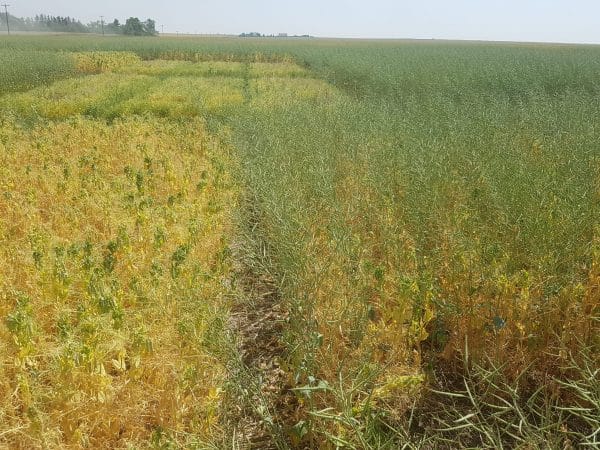Lethbridge-based Eric Bremer, head of R&D for Western Ag Innovations, has learned a thing or two about intercropping during his time researching the practice.
“Intercropping can have substantial benefits, but not always. You have to have some good-sized benefits come out of it in order for it to be widely adopted. Growers want to know it’s going to work for them before taking it on,” Bremer says. He’s currently conducting research trials intercropping canola with pulses like pea and lentil.
For producers considering intercropping for the first time, Bremer says it’s important to “start small,” and get comfortable with the process before growing whole quarters.
Accidents Happen
Derek Axten started intercropping by accident in 2009, when he seeded a field of brown mustard into lentil stubble. When he harvested the field, he expected to see an overall loss. Instead, the lentil yield matched that of his other lentil fields — and he got a great load of mustard to boot.
“I thought, ‘What if we do this intentionally?’” says Axten, who together with his wife Tannis was named Saskatchewan’s Outstanding Young Farmer in 2017. “It took us until 2011 to get to an organized intercrop. Since then, we’ve always seen a net benefit.”
On their land near Minton and Milestone, Sask., the Axtens grow peas/canola, flax/chickpea, flax/lentil, lentil/mustard, and forage pea, maple pea or winter pea with mustard or canola.
In terms of land equivalency ratios, or the amount of monocropped land needed to achieve yields equal to those of an intercropped system at the same management level, the Axtens average somewhere between 1.25 and 1.3, although they have seen years over 1.5. In 2017, some of their intercropped fields were a wash. “But averaging with the other years we’re still ahead of the game,” he says.
This is in part owing to the fact that they don’t use any nitrogen (N) on their intercrops, because N is supplied by the pulse in each combination. Added to this, disease and insect pressure is so low on their intercropped fields that they almost never have to spray.
It’s not known exactly why most intercrops see a reduction in disease and insect pressure, according to Scott Chalmers, diversification specialist for Manitoba Agriculture’s Westman Agricultural Diversification Organization (WADO). But the data is there to prove this is often the case.
Chalmers has been studying intercrop mixtures since 2009, mostly focusing on yield and nitrogen and phosphorous interactions in pea/canola (or peanola) intercrops.
Intercropping with canola has major benefits for peas: because peas, which typically fall to the ground, are held up by the canola, they experience less disease pressure and pea quality is higher. They are also much easier to harvest. “You’re not having to drag your combine knife through the ground,” says Chalmers. “It’s easier on the equipment.”
Axten says intercropping is an attempt to mimic what happens in a “highly functioning, highly diverse” native ecosystem, where some 120 or more species might coexist. “We’ve been growing two crops together, which is nothing like it is in a native system. But we’ve been seeing an improvement with two crops over one, and since then we’ve added clovers as companion crops.”
But intercropping is not about altruism for the Axtens: it’s a business decision. “We’ve never ever had less profit from intercropping,” he says. “And with the reduction of inputs you’re carrying so much less risk. It’s about how much money you keep as well as how much you make.”
Assessing the Risk
But any attempt to intercrop can make growers quickly realize just how many stumbling blocks they may run into. The process can be incredibly detailed.
Bremer has collaborated on his intercropping project with Alberta Agriculture agronomy research scientist Doon Pauly. In this particular experiment, Pauly notes that the pulse crop was the primary one that researchers were attempting to grow, with canola being the “bonus” crop. For the purposes of the research, Pauly and Bremer had to carefully manage the canola through low seeding rates and fertilizer placement and timing, to ensure it didn’t take over the pulse crop.
For seeding, Pauly and the team ran their pulse seed through the seeding discs and the canola seed through sideband fertilizer discs in a single pass.
“The fertilizer component of the current project is really interesting,” says Pauly. “We applied a known fertilizer volume at constant pressure to the entire plot using four drip irrigation lines for the eight rows of pulse and eight rows of canola.”
Fertility treatments were applied within days of seeding (theoretically N at this time should limit the pulse crop’s ability to fix N and also feed canola, making canola very competitive early) or about a month after seeding in-crop. Because the fertilizer solutions were enriched with low levels of 15N, with isotope analyses of plant material the researchers were able to determine if this surface-applied N was picked up by the pulse crop or the canola crop.
There’s a lot yet to be discovered when it comes to intercropping, Pauly says.
“Even with seeding, it’s not like you can just throw canola seed into your air cart with a pulse crop. If they separate out, you may not get the uniform stand you may desire,” Pauly says.
“Harvest is a challenge, too. If you don’t have good synchronization between crop maturities, you can run into problems. You start intercropping and you think, ‘Whoa, I didn’t anticipate that.’ All of a sudden, you start realizing there are certain things you can no longer do that with monocropping wouldn’t be an issue.”
Intercropping is indeed riskier: according to Colin Rosengren, a founding member of Three Farmers, a Saskatchewan-based business that manufactures camelina oil, it’s hard to get crop insurance on intercrop mixtures. In Saskatchewan, producers can get specialty crop insurance on a portion of their intercrops, which guarantees producers the average on their other insured crops. But Rosengren, who intercrops perhaps three quarters of his 6,000-acre operation, says it isn’t worth it for him.
In fact, he believes most producers who intercrop do not carry crop insurance at all. It’s a catch-22 for the industry, as insurers generally won’t offer insurance until a minimum number of acres are intercropped in a province.
“Acres are very significant, but many aren’t insuring, so the numbers officially aren’t there,” says Rosengren.
In terms of harvesting and selling intercropped mixtures, Chalmers says producers might need to modify equipment or buy rotary harrows or a cleaner and will need at least two working augers. “Harvesting takes quite a bit of coordination,” he says.
Bremer agrees.
“It requires more equipment, and for growers to make that investment, there has to be clear benefit.”
Another risk is if buyers are not okay with a small amount of contamination if seed from another crop is found in a producer’s sample, Chalmers points out. “There’s no way you can clean out every canola seed in pea,” he says. “There’s always going to be half a per cent kicking around.”
Planning for Success
Alberta’s Greg Stamp, director of seed sales for Stamp Seeds based in Enchant, agrees that getting into intercropping could present a number of challenges for growers. Although Stamp Seeds helps clients with cover crop projects, they have yet to experiment with intercropping but have seen some of the work that Bremer and his team have done.
“There is definitely potential for this production practice in the future on the Prairies. When you look at the benefits to producers, with reduced pesticide and fertilizer usage, you can see how it could be an attractive way to diversify your operations,” Stamp says.
“As seed growers we are multiplying and growing seed crops on our farm or in the local area. We really get to know the characteristics and quirks – good and bad – of the varieties we sell and that can be valuable information for producers trying intercropping for the first time. When you know how a variety will perform in your local area sometimes that can make all the difference.”
Stamp notes also that using certified seed, which comes with a guarantee of health and vigour, will further manage agronomic risk in producers’ intercropping efforts as you are starting with a high-quality seed product.
When Rosengren and his Three Farmers partners first started intercropping, they ran strip trials to compare intercropped and monocropped systems, but they soon abandoned the practice because the benefits were so obvious.
“There are a million products that offer two extra bushels of yield per acre, but that’s pretty hard to measure,” he says. “When you’re talking 25 to 30 per cent extra yield, it’s significant enough to measure. It was dramatic enough that we quit doing the strips.”
Axten also believes intercropping is the way of the future for Western Canadian farming.
“I think of all the problems that have happened in agriculture, things that have come to light in the last 15 years. We keep trying to do this monocrop thing, but I don’t think we’re showing that it works very well.”
By Julienne Isaacs & Marc Zienkiewicz





